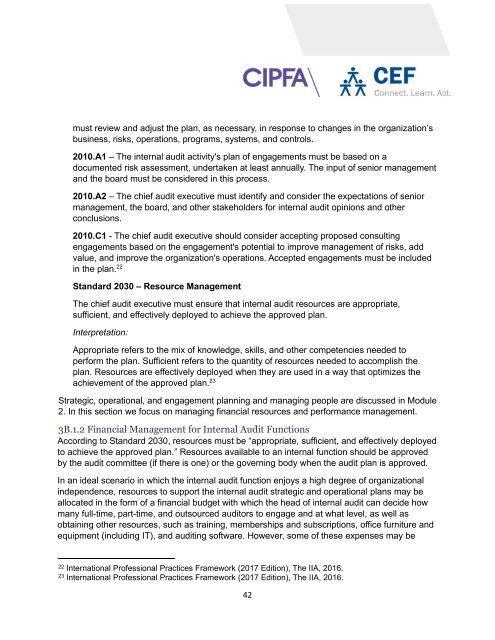Module 3B Managing Resources
You also want an ePaper? Increase the reach of your titles
YUMPU automatically turns print PDFs into web optimized ePapers that Google loves.
must review and adjust the plan, as necessary, in response to changes in the organization’s<br />
business, risks, operations, programs, systems, and controls.<br />
2010.A1 – The internal audit activity's plan of engagements must be based on a<br />
documented risk assessment, undertaken at least annually. The input of senior management<br />
and the board must be considered in this process.<br />
2010.A2 – The chief audit executive must identify and consider the expectations of senior<br />
management, the board, and other stakeholders for internal audit opinions and other<br />
conclusions.<br />
2010.C1 - The chief audit executive should consider accepting proposed consulting<br />
engagements based on the engagement's potential to improve management of risks, add<br />
value, and improve the organization's operations. Accepted engagements must be included<br />
in the plan. 22<br />
Standard 2030 – Resource Management<br />
The chief audit executive must ensure that internal audit resources are appropriate,<br />
sufficient, and effectively deployed to achieve the approved plan.<br />
Interpretation:<br />
Appropriate refers to the mix of knowledge, skills, and other competencies needed to<br />
perform the plan. Sufficient refers to the quantity of resources needed to accomplish the<br />
plan. <strong>Resources</strong> are effectively deployed when they are used in a way that optimizes the<br />
achievement of the approved plan. 23<br />
Strategic, operational, and engagement planning and managing people are discussed in <strong>Module</strong><br />
2. In this section we focus on managing financial resources and performance management.<br />
<strong>3B</strong>.1.2 Financial Management for Internal Audit Functions<br />
According to Standard 2030, resources must be “appropriate, sufficient, and effectively deployed<br />
to achieve the approved plan.” <strong>Resources</strong> available to an internal function should be approved<br />
by the audit committee (if there is one) or the governing body when the audit plan is approved.<br />
In an ideal scenario in which the internal audit function enjoys a high degree of organizational<br />
independence, resources to support the internal audit strategic and operational plans may be<br />
allocated in the form of a financial budget with which the head of internal audit can decide how<br />
many full-time, part-time, and outsourced auditors to engage and at what level, as well as<br />
obtaining other resources, such as training, memberships and subscriptions, office furniture and<br />
equipment (including IT), and auditing software. However, some of these expenses may be<br />
22<br />
International Professional Practices Framework (2017 Edition), The IIA, 2016.<br />
23<br />
International Professional Practices Framework (2017 Edition), The IIA, 2016.<br />
42
















